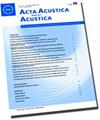Auralization of a Car Pass-By Using Impulse Responses Computed with a Wave-Based Method
Q1 Arts and Humanities
引用次数: 7
Abstract
Auralization of traffic noise can be of great value for city planners and in the communication to citizens. In inner city environments, auralization of traffic noise based on predictions might require a wave-based method for the low frequencies. In this paper, a method to auralize a car pass-by using binaural impulse responses (BIRs) computed with the wave-based pseudospectral time-domain method (PSTD) in two dimensions is presented. A dry synthesized car signal is convolved with the BIRs for different locations in the street, and cross-fade windows are used in order to create a smooth transition between the source positions. Auralizations were performed for the simplified scenarios where buildings are absent, and for an environment where a long flat wall is located behind the car, opposite from the receiver. A same-different listening test was carried out in order to investigate whether increasing the angular spacing between the discrete source positions affects the perception of the car pass-by auralizations. Signal detection theory (SDT) was used for the design and analysis of the listening test. Results showed that differences exist, although they are difficult to notice. On average, 52.3% of the subjects found it almost impossible to spot any difference between auralizations with larger angular spacing (up to 10°) compared to the reference auralization (2° angular spacing).使用基于波的方法计算脉冲响应的汽车通过的听觉化
交通噪声的听觉化对城市规划者和市民的交流具有重要的价值。在内城环境中,基于预测的交通噪声的听觉化可能需要一种低频的基于波的方法。本文提出了一种利用基于波的伪谱时域法(PSTD)计算二维双耳脉冲响应(BIRs)来识别车辆通过的方法。干合成的汽车信号与街道上不同位置的bir进行卷积,并使用交叉渐隐窗来创建源位置之间的平滑过渡。在没有建筑物的简化场景中,以及在接收器对面的汽车后面有一堵长而平的墙的环境中,进行了听觉化。为了研究增加离散声源位置之间的角间距是否会影响汽车经过的听觉感知,进行了相同-不同的听力测试。采用信号检测理论(SDT)对听力测试进行设计和分析。结果表明,差异是存在的,尽管很难注意到。平均而言,52.3%的受试者发现,与参考耳距(2°角间距)相比,角间距较大的耳距(高达10°)几乎不可能发现任何差异。
本文章由计算机程序翻译,如有差异,请以英文原文为准。
求助全文
约1分钟内获得全文
求助全文
来源期刊
CiteScore
2.60
自引率
0.00%
发文量
0
审稿时长
6.8 months
期刊介绍:
Cessation. Acta Acustica united with Acustica (Acta Acust united Ac), was published together with the European Acoustics Association (EAA). It was an international, peer-reviewed journal on acoustics. It published original articles on all subjects in the field of acoustics, such as
• General Linear Acoustics, • Nonlinear Acoustics, Macrosonics, • Aeroacoustics, • Atmospheric Sound, • Underwater Sound, • Ultrasonics, • Physical Acoustics, • Structural Acoustics, • Noise Control, • Active Control, • Environmental Noise, • Building Acoustics, • Room Acoustics, • Acoustic Materials and Metamaterials, • Audio Signal Processing and Transducers, • Computational and Numerical Acoustics, • Hearing, Audiology and Psychoacoustics, • Speech,
• Musical Acoustics, • Virtual Acoustics, • Auditory Quality of Systems, • Animal Bioacoustics, • History of Acoustics.

 求助内容:
求助内容: 应助结果提醒方式:
应助结果提醒方式:


